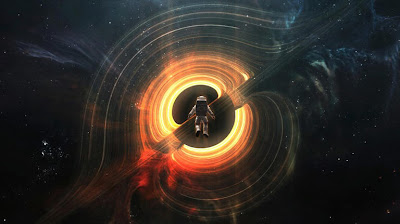BY RICHARD MILNER
It’s a notion not unfamiliar to sci-fi fans: within black holes entire universes await. If we were to somehow breach the event horizon of a black hole and survive the journey into its interior, tales say, we could access new and unimaginable realities, dimensions, and truths beyond the ken of our myopic ape senses. We might even come across Matthew McConaughey in a 4D library from 2014’s “Interstellar.”
But because nothing except Hawking radiation escapes a black hole’s gravitational stranglehold (per ThoughtCo.), there’s a problem: the journeyer wouldn’t be able to come back. A trip into a black hole would be a one-way trip that would rock the fundaments of human knowledge, but none of that knowledge could ever be communicated to anyone else. Or at least, this is what our own imaginations and fictions tell us. What do actual scientists and researchers say?
Believe it or not, some scientists and researchers say the exact same thing, as Big Think outlines. Or rather, they talk less about other universes and more about us. What if we — and our entire universe — are inside a black hole? What if the edge of the cosmos that we can never reach is actually the event horizon of a black hole we could never breach? It sounds fanciful, even ridiculous. And yet, it’s not only plausible but solves a lot of problems with physics. The next question is: How could we ever escape our black hole prison and know for sure?
The Big Bang’s Ignition

Big Bang Exploding Outward
Pixelparticle/Getty Images
Many people have likely wondered: If the Big Bang started everything, what existed before the Big Bang? This question is practically identical to its theological version: If God made everything, what made God? Some suggest that we just have to accept that we’ll never understand the answers to such questions, as Big Think describes. After all, even the James Webb Space Telescope — the most powerful telescope in history — can see all the way to 100 million years after the Big Bang (per NASA), but it can’t pierce the first moments of existence.
We know that the Big Bang happened about 13.7 billion years ago. By 10-36 seconds after the Big Bang — one trillionth of a trillionth of a trillionth of a second, per Space.com — space inflated like a balloon. The first protons and neutrons formed about 10-6 seconds after the Big Bang, and by three minutes, we’ve got our first element, deuterium (a type of hydrogen).
And before the Big Bang? Some researchers postulate that the universe existed as a single, infinitely dense point called a singularity. That singularity ruptured and hasn’t stopped expanding since. As Big Think continues, this is basically the opposite of a black hole. A black hole is also an infinitely dense point in spacetime. Rather than spew everything out, though, it draws everything in. Could there be a connection there? Could the formation of a black hole equal the ignition of a new universe inside it?
Beyond The Event Horizon

At this point, some readers might raise their hand and say, “Yeah, but black holes aren’t the size of the universe.” True enough. A tiny black hole like XTE J1650-500 has an event horizon — an outer rim — of 15 miles across, per Scientific American. The biggest black hole in existence, the mind-splittingly gargantuan Ton 618, has an event horizon of 262 billion miles across, or 43 times the diameter of our solar system, as Earth Sky says. As absurdly big as that is, the entire universe is about 23 trillion light-years across, as Forbes explains. Even the part we can only see — 1/250th of the entire cosmos — houses 2 trillion galaxies, per Big Think. How could all that be inside a black hole?
First off, remember that space is full of lots of just that — space — more than matter. But more importantly, remember that all black holes are points. The size of a black hole’s event horizon depends on the black hole’s mass, as Wondrium Daily tells us. More mass equals bigger radius. We can reliably calculate that radius, the Schwarzschild radius, based on the equation Rg = 2GM/c2 written by German physicist Karl Schwarzschild. And insanely enough, if you gathered all the mass of our universe into a single bundle and plugged it into that equation, you’d get a radius that equals exactly the amount of the universe we can see.
Trapped In A Cosmic Donut
Okay, how about the edge of the universe? Is it possible to fly up to the edge of the cosmos and peer out of a one-way black hole mirror and into the universe that our universe nests within? Sadly, no. As Science ABC explains, the universe is expanding so quickly that we could never reach the edge. But more importantly, there is no edge. Because of the open curvature of spacetime, our universe is most likely shaped like a donut, as Live Science explains. Keep going, and you’d loop around to the same spot.
And just like how you can’t reach the edge of the universe, it’s impossible to reach the center of a black hole. But doesn’t a black hole suck up everything, you ask? Yes, but none of what it sucks up reaches its center intact. As the YouTube channel Astrum explains, objects caught in a black hole’s gravity are drawn to a black hole’s center at speeds approaching (but not quite) the speed of light. As Einstein stipulated through his theory of special relativity and acclaimed E = mc2 equation, time stops for objects moving at the speed of light, per Phys.org. An object caught by a black hole won’t live forever, though. Via a process dubbed “spaghettification,” objects within a black hole’s accretion disk — the distorted spacetime shape surrounding its singularity, per Sky at Night Magazine — are molecularly shredded while stuck at near-zero time (via Popular Mechanics).
The Black Hole Multiverse

© vchal/Shutterstock
So if our universe exists within a black hole that exists within another universe, does that mean that reality is composed of a nested set of universes containing black holes that contain universes that contain black holes that contain universes that contain etc., etc., etc.? As wild as that sounds, yes. If it’s true that each black hole contains its own distinct universe, then the true shape of the multiverse is something like a tree that keeps splintering into branches that split into further branches. As National Geographic quotes physicist Nikodem Poplawski of the University of New Haven, each black hole represents a “one-way door.” If this is true, then we still run across our original, “What caused the first universe?” question, i.e., “What made God?” There are no answers for this.
That being said, the black hole universe theory does help us solve a couple of other issues with physics. Namely, as Big Think explains, it might help explain dark energy. Dark energy is the unknown property that’s fueling the expansion of the universe. No one knows what it really is, or why the universe not only continues to expand but expands at an accelerated rate. So what if dark energy is caused by matter from outside of our black hole universe getting drawn into the black hole? The matter from outside becomes energy inside and fuels our expansion. This also might help explain the early, rapid inflation of the universe following the Big Bang.
Testing The Untestable

Universe overlaid with equations
© Triff/Shutterstock
Even though the black hole universe theory answers some questions, it raises others. As Inside Science points out, the theory doesn’t explain why our universe’s initial inflation slowed down. We also don’t know how matter from the outside becomes energy inside. Plus, we already mentioned the “What caused the initial universe?” problem. But assuming we can resolve all these issues, it’s unlikely we’d ever surmount a final, ultimate roadblock, as Big Think outlines: How could we begin to test this all? How could we check to see if we’re inside a black hole? We can’t approach the universe’s edge because there isn’t one. If objects entering our universe are spaghettified along the way, we can’t exactly chat with an explorer on a one-way trip from our parent universe.
Ultimately, we’ve got two lines of inquiry to investigate: cosmic microwave background (CMB) radiation and Hawking radiation. CMB is a palette of evenly distributed, extremely cool cosmic energy left over from the Big Bang, as Space.com says. Scientists like Roger Penrose have pointed to CMB to say that it contains evidence of a universe that existed before the Big Bang, but he hasn’t produced a lot of hard evidence. Hawking radiation is energy lost by black holes over a long period of time. Would we be able to track such a loss in our own cosmos as energy spills out of it? If not, we might have to do what sites like Big Think suggest and accept not knowing.
SOURCE: GRUNGE





























